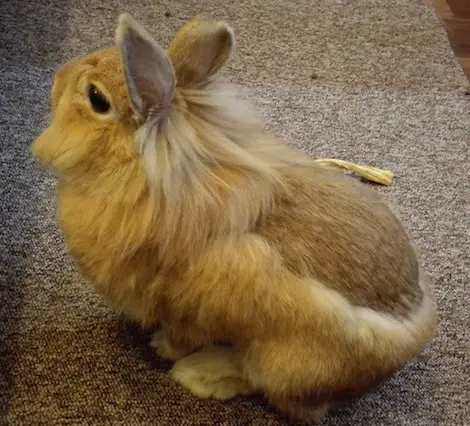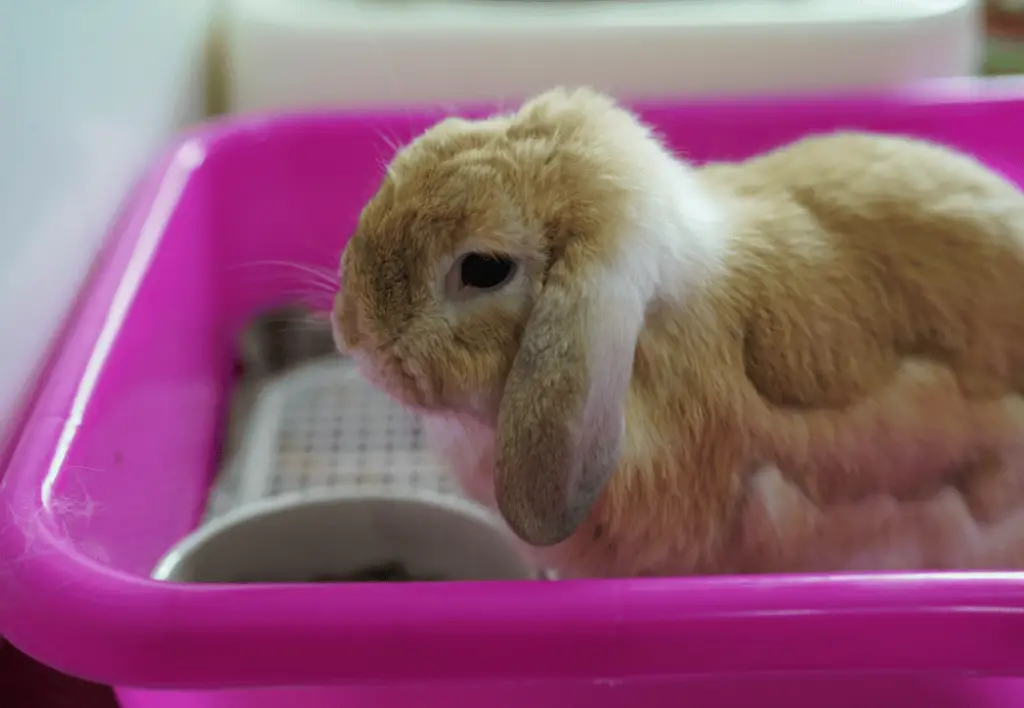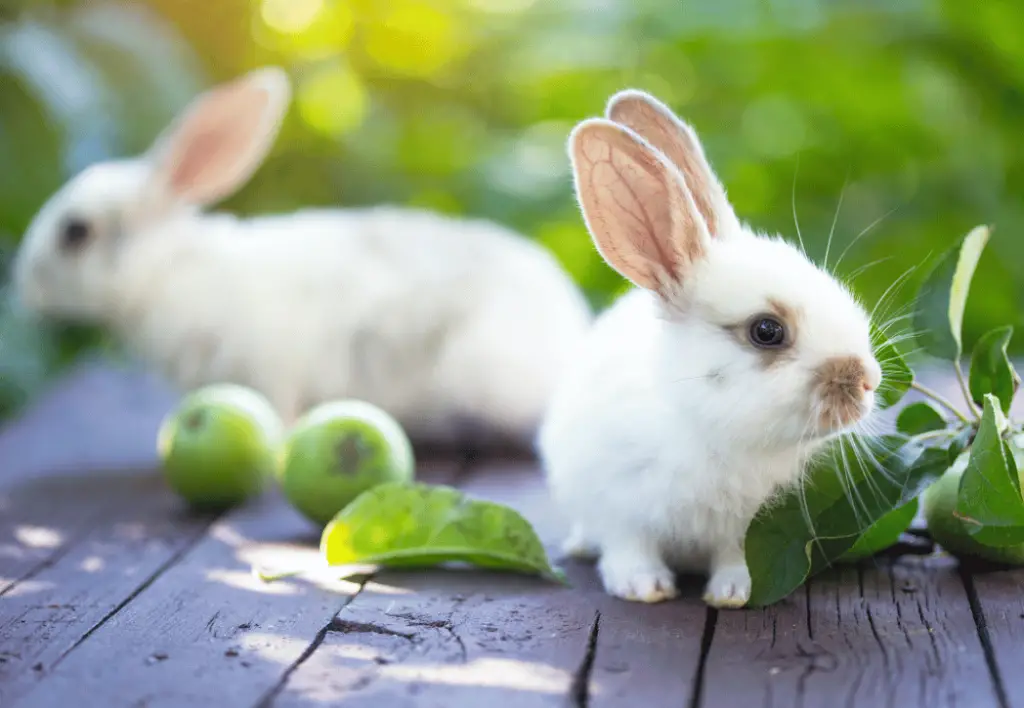Last Updated on July 17, 2023 by Leonard Harper
This post contains affiliate links. Read more here.Just like most hairy mammals, rabbits are going to shed their fur, or molting as it is more commonly known. On this page, we want to share with you a little bit of information about rabbit shedding, as well as provide you with a few tips and tricks which should ensure that rabbit shedding is as hassle-free as possible, both for you and your rabbit.
- Do Rabbits Shed?
- How Often Does A Rabbit Shed?
- Change of Behavior
- What Can Help You While Rabbit’s Shedding?
- Can You Stop or Reduce Rabbit Shedding?
- Rabbits May Not Want To Be Held When Shedding
- Normal Rabbit Shedding
- Seasonal Shedding Patterns
- Abnormal Rabbit Shedding
- Stress
- Diet and Nutrition
- Lack of Exercise
- Grooming
- Health Concerns
- Healthy Diet and Nutrition
- Regular Grooming
- Exercise and Playtime
- Veterinary Care
One of the most common reasons why rabbits shed in clumps is due to a change in their diet. Rabbits have sensitive digestive systems, and sudden changes in their diet can cause stress and lead to excessive shedding. Another reason why rabbits may shed in clumps is due to fur blockages. Rabbits groom themselves by licking their fur, and if they ingest too much fur, it can form a blockage in their digestive system, leading to clumps of fur in their stool.
If you are a rabbit owner, it is important to be aware of the signs of excessive shedding and to take steps to prevent it. By understanding the reasons why your rabbit may be shedding in clumps, you can take the necessary steps to keep your furry friend healthy and happy.

Do Rabbits Shed?
Yes., rabbits Shed. The reason why rabbits shed is so that they are able to grow a new coat of fur. The shedding process will also help the animal to shift its winter coat. After all, your rabbit will need thicker fur during the winter months in order to ensure that they stay nice and warm.
As they head into summer, they will start to lose this thicker fur to ensure that they do not overheat during the warmer months.
How Often Does A Rabbit Shed?
Honestly, this is a tough question to answer. It is going to be completely dependent on the rabbit, and it is something that you are going to need to look out for yourself. Generally speaking, rabbit shedding is going to happen at least twice per year. However, some rabbits are known to shed every three months or so.
If you are regularly grooming your rabbit, then you should be able to spot when rabbit shedding occurs. You will start to notice the hair loosening up around their nose, and over time, they will start to shed their fur across their bodies.
You may spot hairballs around your home frequently too or inside their hutch. Basically, you are going to know when rabbit shedding occurs. It is going to happen like clockwork too. So, once you know which frequency your rabbit is shedding at, you will be able to predict roughly when it is going to happen again.
Remember; if you have a rabbit with a longer coat, then it is likely that they are going to be shedding a lot more frequently.
Change of Behavior
When a rabbit is shedding, it is likely that you will spot a change in their behavior. They tend to become very defensive, and some rabbits can be quite aggressive, during the shedding process, particularly when they are in the height of it (i.e. when the fur is starting to be shed from the bulk of their body).
You may find that the rabbit will barely let you touch it at this time. Sadly, it is something that you will need to do. You are going to need to groom your pet in order to help them through the shedding process. You need to be doing it at least once per day, particularly for rabbits with longer fur like the Lionheads, otherwise, the fur will become difficult to manage.
What Can Help You While Rabbit’s Shedding?
When your pet rabbit is shedding, it is vital that you groom them. This will serve multiple purposes:
- It will stop you finding hair around the home.
- Your rabbit will not get caught on furniture and other items, which could cause pain.
- Your rabbit is less-likely to ingest a fur-ball, which could actually cause death (albeit rarely).
It is worth noting that rabbit shedding can cause the rabbit’s skin to be a bit more sensitive. This means that you will need to invest in a quality grooming kit for your rabbit. You will want to make sure that it comes complete with a soft brush.
You will also need to be incredibly gentle when you are running the brush over the rabbit’s skin. This will ensure that your rabbit is in the minimum amount of pain when it is molting.
If you are looking for suggestions for grooming tools to help with rabbit shedding, then you will find that we have found a good selection of them: Best Rabbit Brush For Shedding.
These are the ones that we use with our rabbits, and that means we know that they are going to be fantastic for your animals too.
Can You Stop or Reduce Rabbit Shedding?
You can’t. It is a completely natural process. The only thing you can do to stop finding hair around your home is to brush the rabbit regularly. You don’t want to stop the shedding process anyway. The rabbit will either get too hot or too cold.
Rabbits May Not Want To Be Held When Shedding
It is worth noting that when a rabbit is shedding, it is unlikely that they will want to be held. They tend to get a little bit feisty. This is because their skin is going to be incredibly sensitive. The best thing you can do when a rabbit is shedding is to not touch them.
The only time that you should be touching them is if you are grooming them with a soft brush (they love this!). This does mean a week or two without cuddling up to your rabbit, but we are sure that this is going to be fine for you.
Understanding Rabbit Shedding

Rabbits are known for their soft and fluffy fur, but shedding is a natural part of their life cycle. Understanding rabbit shedding is important for pet owners to ensure their rabbits are healthy and happy. In this section, we will discuss normal rabbit shedding, seasonal shedding patterns, and abnormal rabbit shedding.
Normal Rabbit Shedding
Rabbits shed their fur to regulate their body temperature and get rid of old or damaged fur. Normal shedding occurs throughout the year and is usually not a cause for concern. During shedding season, rabbits may shed more than usual, resulting in clumps of fur. This is a natural process and should not cause any pain or discomfort to the rabbit.
Seasonal Shedding Patterns
Rabbits have two main shedding seasons: spring and fall. During these periods, rabbits will shed their winter coat to prepare for the warmer weather or grow their winter coat back in preparation for the colder months. Seasonal shedding patterns are a normal part of a rabbit’s life and should not be a cause for concern.
Abnormal Rabbit Shedding
Abnormal rabbit shedding can occur due to various factors such as ill health, poor nutrition, or skin disease. Excessive shedding, bald patches, patchy hair loss, dander, flaky skin, scabs, and inflammation are signs of abnormal fur loss. Parasite infections, bacterial infections, fur mites, mange mites, lice, and ear canker mites can also cause abnormal shedding. Overgrooming, false pregnancies, and dominance behavior can also lead to hair loss in rabbits.
Pet owners should monitor their rabbits’ shedding patterns and seek veterinary attention if they notice any abnormal shedding. A healthy diet, fresh water, and plenty of exercise can help maintain a rabbit’s coat and prevent abnormal shedding. Regular grooming can also help remove excess fur and prevent matting.
Understanding rabbit shedding is crucial for pet owners to ensure their rabbits are healthy and happy. Normal shedding occurs throughout the year, while seasonal shedding patterns occur in spring and fall. Abnormal shedding can be a sign of disease or poor nutrition and should be addressed promptly. With proper care and attention, rabbits can maintain a healthy coat and live a happy life.
Causes of Excessive Shedding in Rabbits
Rabbits naturally shed their fur to make way for new growth, but sometimes shedding can become excessive and result in clumps of fur falling out. There are several reasons why a rabbit may experience excessive shedding, including stress, diet and nutrition, lack of exercise, grooming, and health concerns.
Stress
Stress can cause a rabbit to shed excessively. Rabbits are sensitive animals and can become stressed by changes in their environment, such as moving to a new home or the introduction of a new pet. Stress can also be caused by loud noises, lack of socialization, or being handled too roughly.
Diet and Nutrition
A rabbit’s diet plays a crucial role in their overall health and can affect their fur. A diet lacking in fiber or fresh vegetables can lead to poor nutrition and sensitive skin, resulting in excessive shedding. It is important to provide a healthy diet with plenty of fresh vegetables and high-quality hay to support a rabbit’s digestive system and overall health.
Lack of Exercise
A lack of exercise can also contribute to excessive shedding in rabbits. Regular playtime and exercise can help prevent overgrooming and hormone imbalances that can lead to patchy hair loss.
Grooming
Proper grooming is essential to prevent excessive shedding in rabbits. Regular brushing can help remove loose fur and prevent the formation of clumps. A professional groomer or veterinarian can also provide assistance in grooming your rabbit.
Health Concerns
Excessive shedding can also be a sign of health concerns such as fur mites, skin infections, dental issues, or cancer. If you notice patchy fur loss or other signs of ill health, it is important to consult with a veterinarian.
Excessive shedding in rabbits can be caused by a variety of factors, including stress, diet and nutrition, lack of exercise, grooming, and health concerns. By providing a healthy diet, plenty of exercise, and proper grooming, you can help prevent excessive shedding and maintain your rabbit’s overall health and well-being.
Preventing and Treating Excessive Shedding in Rabbits

Rabbits naturally shed their fur throughout the year, but excessive shedding can be a sign of an underlying health issue. If you notice your rabbit shedding in clumps, it’s important to take action to prevent and treat the problem.
Healthy Diet and Nutrition
A healthy diet is essential for preventing excessive shedding in rabbits. Ensure your rabbit’s diet is high in fiber, with plenty of fresh vegetables and fruits. A poor diet can lead to digestive problems and contribute to shedding. Make sure your rabbit has access to fresh water at all times and avoid giving them sugary treats.
Regular Grooming
Regular grooming is essential for keeping your rabbit’s coat healthy and preventing excessive shedding. Brush your rabbit’s fur regularly to remove loose hair and prevent matting. If your rabbit has sensitive skin, use a soft brush or grooming mitt to avoid irritation. Consider taking your rabbit to a professional groomer for a trim if their fur is particularly long or prone to matting.
Exercise and Playtime
Providing your rabbit with plenty of exercise and playtime can help prevent excessive shedding. Rabbits need space to run and play, so make sure they have a large enough enclosure or space to move around in. Provide toys and activities to keep your rabbit entertained and mentally stimulated.
Veterinary Care
If your rabbit is shedding excessively, it’s important to take them to a veterinarian for a checkup. Excessive shedding can be a sign of an underlying health issue, such as skin mites, allergies, or a hormone imbalance. Your veterinarian can diagnose and treat any health problems and provide advice on preventing excessive shedding in the future.
Overall, preventing and treating excessive shedding in rabbits requires a combination of a high-quality diet, regular grooming, exercise and playtime, and veterinary care. By taking these steps, you can help keep your rabbit healthy and happy and prevent patchy hair loss and other shedding-related problems.
Frequently Asked Questions
Laura is an experienced wildlife rehabilitator and conservationist residing in Madison, Wisconsin. Her love for rabbits was sparked during her early career when she nursed an injured wild rabbit back to health. Today, she runs “Hoppy Haven”, a rehabilitation center dedicated to the care and release of injured wild rabbits.


